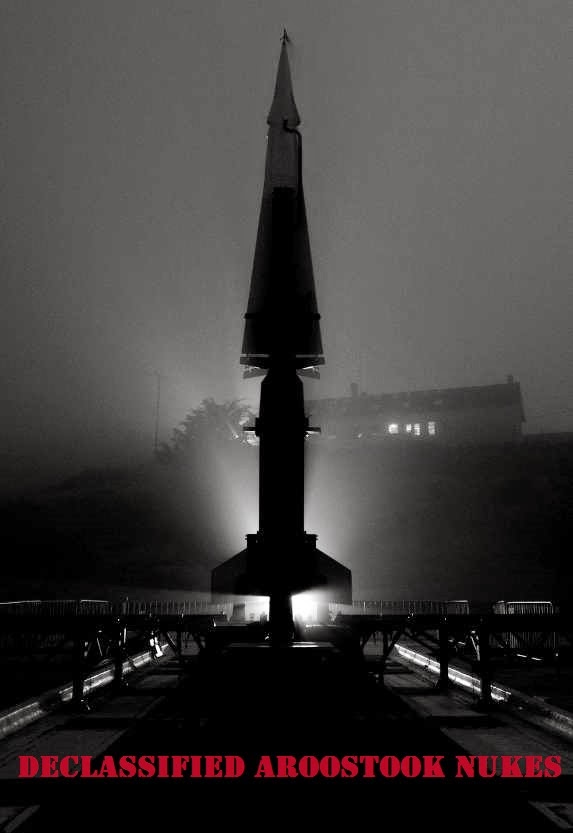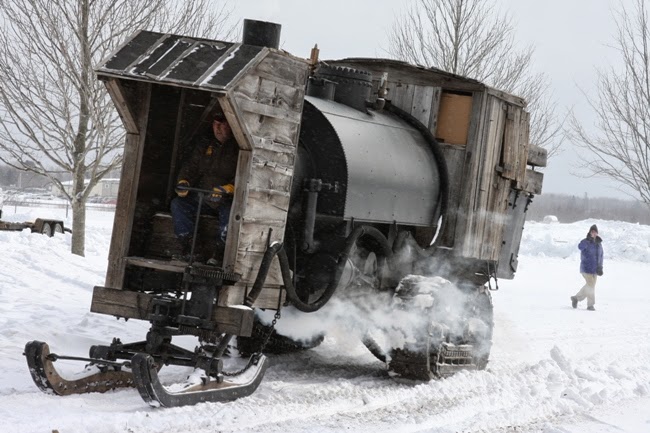In the woods of Perham, ME (population around 500), you'll find a
component of the very first world wide communications network, crumbling
and covered in graffiti. While this site may be one of many like it
across the globe it's noteworthy in that, in addition to the SAGE
blockhouse at Brunswick AFS, it was yet another example of Maine's
location relative to the Soviet threat of the time causing us to be on the forefront of communications, technology, and defense.
Long before you could push a button on your
komputerphone and within seconds be on your way to all the cat videos you could ever want, you had to use a modem to look at cat pictures. A modem was a device that modulated/demodulated analog tones for direct communications with another computer. Before using a modem to look at cat pictures, you had to use an acoustic coupler so your computer could send tones over plain old telephone service to gain access to text-only cat stoires. And before that having to use an acoustic coupler? You were kind of SOL if you wanted to use the "internet" as it was before then, unless you were in government or academia you had to use ARPANet, the world's first packet swtiched network. Before ARPANet if you wanted to send messages across the world, you had to send them for a very specific purpose and from very specific locations using a series of short-wave, high frequency, trunked radio networks or use a store-and-forward torn tape system that effectively routed information Western Union style across the globe.
Take a look at the floor plan below and the shape will make a lot more sense.
This site was a big deal for several reasons. Foremost GLOBECOM (Later to be renamed STRATCOM) was the manifestation of a change in strategy resulting from the Korean War that reorganized communications from a structure relying on a theater commander with singular control to a structure relying on functional control. That meant for the first time that commands had instantaneous control of their assets more or less whenever they wanted. Anything from scheduling refueling, airlift ops, communications during an "alert", weather information or even reconnaissance. This building is a part of the
very first system to allow that sort of geographically widespread, instantaneous communication. GLOBECOM brought the state of internet-like communication from a network of single channel voice/teletype/tape relays to a robust analog high frequency network.
 |
| GLOBECOM/STRATCOM interior via Flickr |
As the Perham site was active from 1955-1962 (
here's an aerial image from 1953 showing an empty field), it conceivably would have had a few different capabilities as technology improved. Above is a photograph of a site in Germany with a similar purpose. The consoles lining either side of the hallway were a part of the militarized version of Western Union's
Plan 55 in which precursors to serial modems would store, analyze and route messages stored on paper tape between sites. By the late 1950s high frequency microwave communications would have taken the place of analog torn tape routing, but, there is very little evidence of microwave transmission equipment visible from the air compared to other sites with more recent histories. A topographic map from 1963 does hint at the presence of microwave equipment; and I don't use AdWords so this falls under a non-commercial use ;)
 |
| HistoricAerials.com in case you missed it. Non-commercial use. |
See those circles going along both sides of the road and coming to a point? Aerial imagery from 1996 when compared to the above topo image from 1963 leads me to believe that there was HF microwave transmission equipment there at one time.
These circles on the map to the left are the only clue I have been able to find as to whether or not the air force did end up upgrading this facility away from Plan 55.
Take a look at the aerial image on the right from 1996. The roads to the north have the same shape and bearing as the circles on the topo map, which is not visible in more current aerial photos.
There are also concrete conduit bases onsite heading in the direction of the circles just mentioned. They're visible in the photographs below. Although these could have also been for HVAC as I have no detailed layout specific to the original site, whether or not the Air Force had found the time to upgrade this facility, and the 2192nd Communications/AACS Squadron away from Plan 55 is conjecture.
Suffice it to say that between the 'circles' on the topo map from 1963, the aerial images from 33 years later, and these apparent conduit beds leading in the direction of what would have likely been antennae, I'd be willing to conjecture that yes - the Air Force did upgrade this facility from Plan 55 to microwave communications.
 |
| All-Hazards.com, used with permission (Click to Enlarge) |
 |
| All-Hazards.com, used with permission (Click to Enlarge) |
|
|
While on the topic of conjecture, below is a handy map to show you just how far this one communications facility could theoretically reach if outfitted with HF Microwave equipment (3000 miles) . That green spot? The communications radius of the facility's reach. The blue dot? That's Perham. Again, comparing the '63 topo map to the '96 photo, it's possible.
 |
| Freemaptools.com Radius tool |
Between 1955 and 1962 this site was manned by the
2192d AACS Squadron (later to be named the 42nd Communications Squadron) Other information from local media is scant....
- May, 1961: The Lewiston Daily sun reports that the Communications Annex (Perham Globecom) and "Receiver B" in Caribou were to be closed.
- November, 1990: The Bangor Daily News reports the death of two in a small plane crash. They crashed on the access road to the facility. Authorities were unable to find any mechanical failures.
Apart from the opening in 55 and the closure in 62, that's really all there is on the web regarding this site apart from pictures taken long, long after the fact. Here is a sample of what's available over at
All-Hazards.com and this particular
Loring Legend entry.
Click any of the photos to enlarge them.
 |
| "Wade, you're a big puss for not goin' to the titty bar with us" |
 |
| This would have been aclatter with state of the art period electronics. |
 |
| According to blue prints, receiving and storage? |
 |
| Evidence of an awning on the front. |
 |
| This would have been outside the tape relay area. |
 |
| Standing on the lobby, looking at the auto-switching area (according to layout), with the shop on the far right in the back. |
It should be said that since some yahoos have spray painted it and had a few fires, that the locals (and perhaps the constabulary) don't really want people going out there.
Resources and sources:
Loring Legends Entry for Globecom
42nd Communications Squadron Factsheet
2192 AACS/Communications Squadron Patch
AACS Alumni Association 1938-2004
HistoricAerials map.

Rules of engagement for the Florida area prescribe the use of high explosive weapons only. In the event of an IL-28 raid from cuba which penetrates US Air Space, I consider it imperative to use weapons with a maximum kill capability. Ref a. and b. authorize CINCONAD to eimploy (sic) nuclear weapons in air defense within the sovereign boundaries of the us, its territories and possessions, and in the coastal adiz, subject only to currently approved rules for engagement.










































